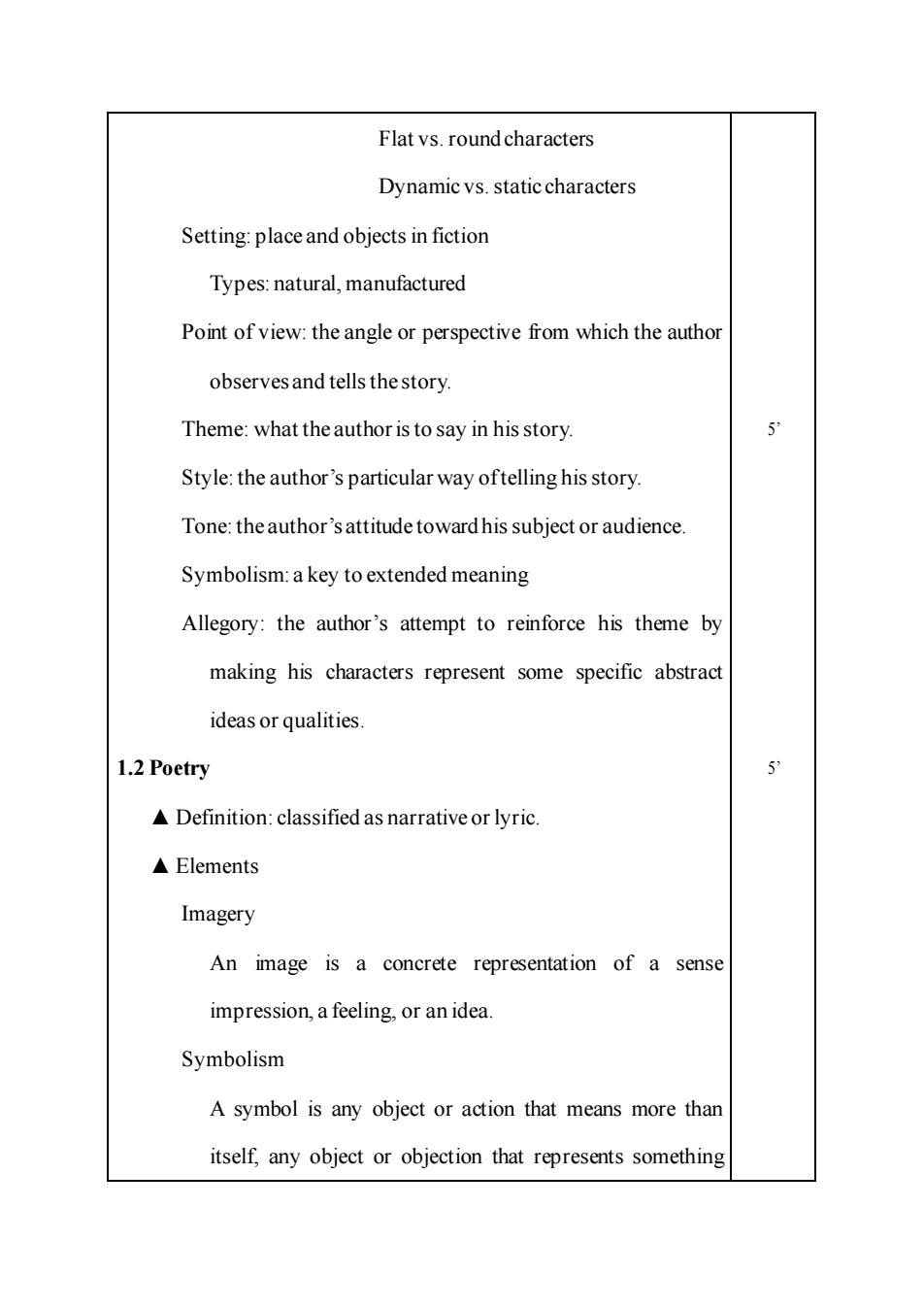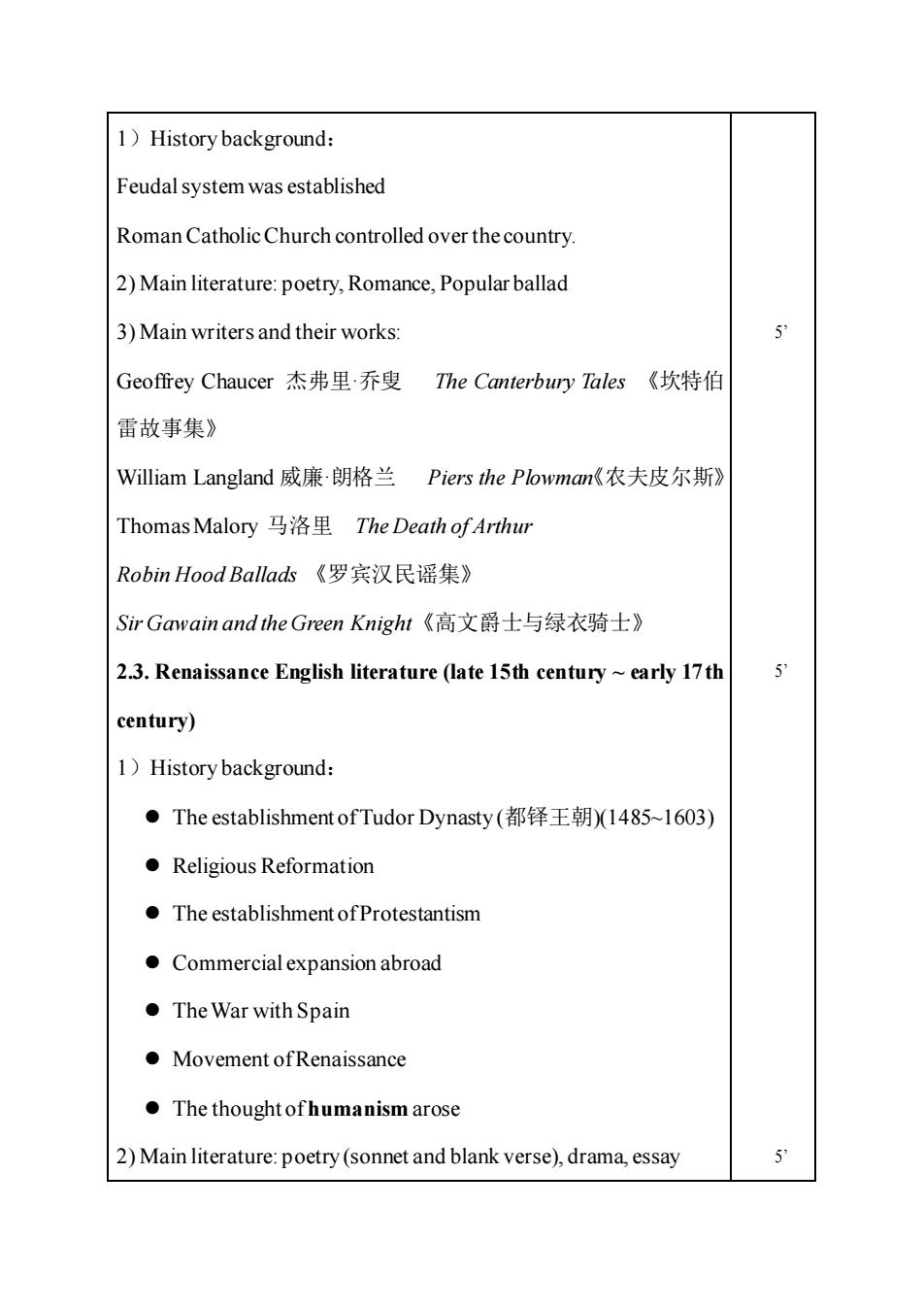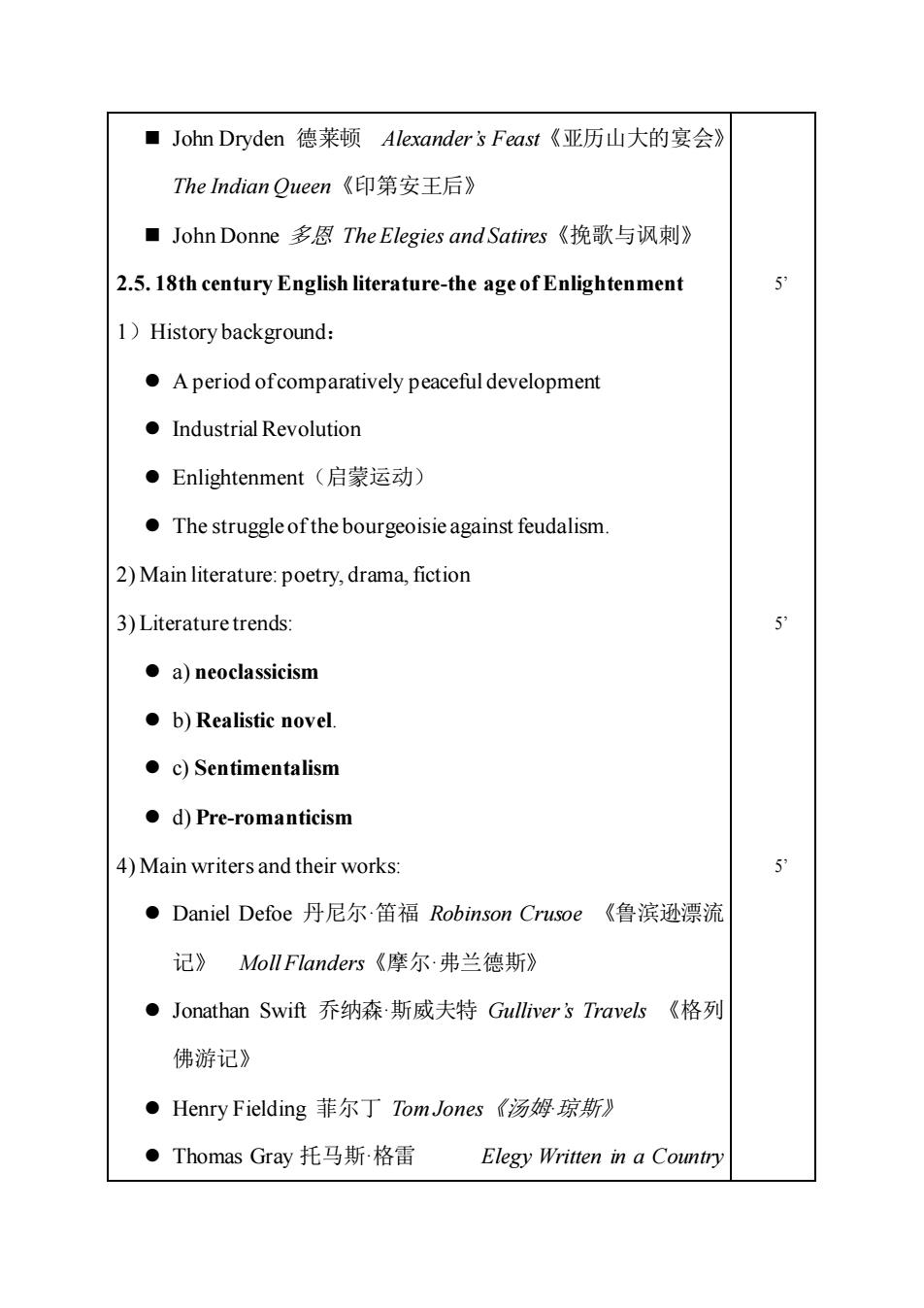
教 案 课程名称 英因文学 授课专业及层次 授课内容 Lecture one: Introduction to literature 学时数 2 To let the students see the significance of literature; 教学目的 To the studentshave the generalimpres sion of British literature To let the students get basic knowledge of British literature 重点 To get to know the general clue of British literary history To get to know the important British writers and literary works 难点 To get to know some key terms 自学内容 Additional reading materials about the western cultural background 使用教具 Projector,audio-video machine 相关学科知识 Western culture and general Literary theories Open questions and answers in class 教学法Class discussion and analysis 讲授内容纲要、要求及时间分配 General Introductionon Literature 1.0 Introduction to the major literary categories 1.1 Fiction Definition:fiction created from the imagination,not presented as fact,though it may base on a true story or situation. ▲Elements Plot:a sequence of interrelated actionsand events Five stages of plot:exposition,complication,crisis falling action and resolution. Characters:the people in fiction 5 Types ofcharacters:protagonist vs.antagonist
教 案 课程名称 英国文学 授课专业及层次 授课内容 Lecture one: Introduction to literature 学时数 2 教学目的 To let the students see the significance of literature; To let the students have the general impression of British literature. To let the students get basic knowledge of British literature 重 点 To get to know the general clue of British literary history To get to know the important British writers and literary works 难 点 To get to know some key terms To know some methods for literary appreciation and criticism 自学内容 Additional reading materials about the western cultural background 使用教具 Projector, audio-video machine 相关学科知识 Western culture and general Literary theories 教 学 法 Open questions and answers in class Class discussion and analysis 讲授内容纲要、要求及时间分配 General Introduction on Literature 1.0 Introduction to the major literary categories 1.1 Fiction ▲ Definition: fiction created from the imagination, not presented as fact, though it may base on a true story or situation. ▲ Elements Plot: a sequence of interrelated actions and events. Five stages of plot: exposition, complication, crisis, falling action and resolution. Characters: the people in fiction Types of characters: protagonist vs. antagonist 5’ 5’

Flat vs.roundcharacters Dynamic vs.static characters Setting:place and objects in fiction Types:natural,manufactured Point of view:the angle or perspective from which the author observesand tells the story Theme:what the author is to say in his story. 5 Style:the author's particular way oftelling his story. Tone:the author'sattitude towardhis subject or audience Symbolism:a key to extended meaning Allegory:the author's attempt to reinforce his theme by making his characters represent some specific abstract ideas or qualities. 1.2 Poetry 53 Definition:classified as narrative or lyric ▲Elements Imagery An image is a concrete representation of a sense impression,a feeling,or an idea. Symbolism A symbol is any object or action that means more than itself,any object or objection that represents something
Flat vs. round characters Dynamic vs. static characters Setting: place and objects in fiction Types: natural, manufactured Point of view: the angle or perspective from which the author observes and tells the story. Theme: what the author is to say in his story. Style: the author’s particular way of telling his story. Tone: the author’s attitude toward his subject or audience. Symbolism: a key to extended meaning Allegory: the author’s attempt to reinforce his theme by making his characters represent some specific abstract ideas or qualities. 1.2 Poetry ▲ Definition: classified as narrative or lyric. ▲ Elements Imagery An image is a concrete representation of a sense impression, a feeling, or an idea. Symbolism A symbol is any object or action that means more than itself, any object or objection that represents something 5’ 5’

beyond itself. Sound:Rhyme,alliteration and assonance 1.3 Drama 5 Definition:a dialogue performed by actors on a stage before an audience. ▲Elements Dialogue Staging Genres:comedy,tragedy and tragic-comedy. 2.0 Introduction to the major British literary periods 2.1 Old English Literature (449A.D.~1066) 5 1)History background: The making of the England:Jutes,Angles and Saxons invaded Albion and combined into one United Kingdom-the England. Their dialects gradually grew into a single language called Anglo-Saxon,or Old English. The transition from tribal society to feudalism 2)Main literature:poetry 3)Main writers:Caedmon,Cynewulf,Venerable Bede and Alfred the Great 4)Main work:The Song of Beowulf 2.2 Medieval English Literature(1066-15th century)
beyond itself. Sound: Rhyme, alliteration and assonance 1.3 Drama ▲ Definition: a dialogue performed by actors on a stage before an audience. ▲ Elements Dialogue Staging Genres: comedy, tragedy and tragic-comedy. 2.0 Introduction to the major British literary periods 2.1 Old English Literature(449A.D. ~ 1066) 1)History background: The making of the England: Jutes, Angles and Saxons invaded Albion and combined into one United Kingdom-the England. Their dialects gradually grew into a single language called Anglo-Saxon, or Old English. The transition from tribal society to feudalism 2) Main literature: poetry 3) Main writers: Caedmon, Cynewulf, Venerable Bede and Alfred the Great. 4) Main work: The Song of Beowulf > 2.2 Medieval English Literature (1066-15th century) 5’ 5’ 5’ 5’

1)History background: Feudal system was established Roman Catholic Church controlled over the country. 2)Main literature:poetry,Romance,Popular ballad 3)Main writers and their works: 5 Geoffrey Chaucer杰弗里乔叟The Canterbury Tales《坎特伯 雷故事集》 William Langland威廉.朗格兰Piers the Plowman《农夫皮尔斯》 Thomas Malory马洛里The Death ofArthur Robin Hood Ballad本《罗宾汉民谣集》 Sir Gawain and the Green Knight《高文爵士与绿衣骑士》 2.3.Renaissance English literature (late 15th century~early 17th 5° century) 1)History background: ●The establishment of Tudor Dynasty(都铎王朝(1485-1603) Religious Reformation The establishment ofProtestantism Commercial expansion abroad ●The War with Spain Movement ofRenaissance The thoughtofhumanism arose 2)Main literature:poetry(sonnet and blank verse),drama,essay 5
1)History background: Feudal system was established Roman Catholic Church controlled over the country. 2) Main literature: poetry, Romance, Popular ballad 3) Main writers and their works: Geoffrey Chaucer 杰弗里·乔叟 The Canterbury Tales 《坎特伯 雷故事集》 William Langland 威廉·朗格兰 Piers the Plowman《农夫皮尔斯》 Thomas Malory 马洛里 The Death of Arthur Robin Hood Ballads 《罗宾汉民谣集》 Sir Gawain and the Green Knight《高文爵士与绿衣骑士》 2.3. Renaissance English literature (late 15th century ~ early 17th century) 1)History background: ⚫ The establishment of Tudor Dynasty (都铎王朝)(1485~1603) ⚫ Religious Reformation ⚫ The establishment of Protestantism ⚫ Commercial expansion abroad ⚫ The War with Spain ⚫ Movement of Renaissance ⚫ The thought of humanism arose 2) Main literature: poetry (sonnet and blank verse), drama, essay 5’ 5’ 5’

3)Main writers and their works: Thomas More托马斯莫尔Utopia乌托邦) Edmund Spencer埃德蒙·斯宾塞The shepherd3 Calendar《牧 人日历》 The Faerie Queene《仙后》 William Shakespeare Francis Bacon Essays《随笔集》 ,Christopher Marlowe克里斯托弗马洛Doctor Faustus《浮士 德博士》 Ben Jonson本琼生olpone《福尔蓬奈》 2.4.English Literature of the Revolution and Restoration Period 5 (17 th century) 1)History background: English Revolution(1649) The establishment ofa Commonwealth The monarchy was restored(1660) Glorious Revolution(1688) 2)Main literature:poetry,comedy,prose 3)Main writers and their works: ■John Milton弥尔顿Paradise Lost《失乐园》Samson Agonistes《力士参孙》 ■John Bunyan班扬The Pilgrim3 Progress(天路历程》
3) Main writers and their works: ·Thomas More 托马斯·莫尔 Utopia《乌托邦》 ·Edmund Spencer 埃德蒙·斯宾塞 The shepherd’s Calendar《牧 人日历》 The Faerie Queene 《仙后》 ·William Shakespeare ·Francis Bacon Essays《随笔集》 ·Christopher Marlowe 克里斯托弗·马洛 Doctor Faustus《浮士 德博士》 ·Ben Jonson 本·琼生 Volpone《福尔蓬奈》 2.4. English Literature of the Revolution and Restoration Period (17th century) 1)History background: ⚫ English Revolution (1649) ⚫ The establishment of a Commonwealth ⚫ The monarchy was restored (1660) ⚫ Glorious Revolution(1688) 2) Main literature: poetry, comedy, prose 3) Main writers and their works: ◼ John Milton 弥尔顿 Paradise Lost《失乐园》 Samson Agonistes 《力士参孙》 ◼ John Bunyan 班扬 The Pilgrim’s Progress《天路历程》 5’ 5’

■John Dryden德莱顿Alexander3 Feast《亚历山大的宴会》 The Indian Queen《印第安王后》 ■John Donne多愿The Elegies and Satires《挽歌与讽刺》 2.5.18th century English literature-the age of Enlightenment 1)History background: A period ofcomparatively peaceful development Industrial Revolution ●Enlightenment(启蒙运动) The struggle ofthe bourgeoisieagainst feudalism 2)Main literature:poetry,drama,fiction 3)Literature trends: 51 ●a)neoclassicism ●b)Realistic novel. ●c)Sentimentalism ●d)Pre-romanticism 4)Main writers and their works: 5” ·Daniel Defoe丹尼尔·笛福Robinson Crusoe《鲁滨逊漂流 记》Moll Flanders《摩尔·弗兰德斯》 ●Jonathan Swift乔纳森·斯威夫特Gulliver3 Travels《格列 佛游记》 ●Henry Fielding菲尔丁Tom.Jones《汤姆琼斯》 ●Thomas Gray托马斯.格雷 Elegy Written in a Country
◼ John Dryden 德莱顿 Alexander’s Feast《亚历山大的宴会》 The Indian Queen《印第安王后》 ◼ John Donne 多恩 The Elegies and Satires《挽歌与讽刺》 2.5. 18th century English literature-the age of Enlightenment 1)History background: ⚫ A period of comparatively peaceful development ⚫ Industrial Revolution ⚫ Enlightenment(启蒙运动) ⚫ The struggle of the bourgeoisie against feudalism. 2) Main literature: poetry, drama, fiction 3) Literature trends: ⚫ a) neoclassicism ⚫ b) Realistic novel. ⚫ c) Sentimentalism ⚫ d) Pre-romanticism 4) Main writers and their works: ⚫ Daniel Defoe 丹尼尔·笛福 Robinson Crusoe 《鲁滨逊漂流 记》 Moll Flanders《摩尔·弗兰德斯》 ⚫ Jonathan Swift 乔纳森·斯威夫特 Gulliver’s Travels 《格列 佛游记》 ⚫ Henry Fielding 菲尔丁 Tom Jones《汤姆·琼斯》 ⚫ Thomas Gray 托马斯·格雷 Elegy Written in a Country 5’ 5’ 5’

Churchyard《墓园挽歌》 William Blake威廉布莱克Songs of Innocence《天真之歌》 Songs ofExperience《经验之歌》 Robert Burns罗伯特彭斯 ARed,Red Rose《一朵红红的玫瑰) 5 Richard Brinsley Sheridan理查德布林斯利谢里丹 The School for Scandal《造谣学校》 The Rivals《情敌》 Alexander Pope亚历山大蒲柏The Rape of the Lock《卷发遇劫 记》 2.6.English Critical Realism 5 1)Historical Background .Queen Victorian(1837-1902) ·Chartist Movement 2)Main Literature:poetry;fiction 3)Literature forms: 5 a)Chartist literature b)Critical realistic novel ●c)Victorian poetry 4)Charles Dickens William Makepeace Thackeray Their main works and characteristics 2.7.The Literature of 20th Century 5 1)Historical background
Churchyard《墓园挽歌》 William Blake 威廉·布莱克 Songs of Innocence《天真之歌》 Songs of Experience《经验之歌》 Robert Burns 罗伯特·彭斯 A Red, Red Rose《一朵红红的玫瑰》 Richard Brinsley Sheridan 理查德·布林斯利·谢里丹 The School for Scandal《造谣学校》 The Rivals《情敌》 Alexander Pope 亚历山大·蒲柏 The Rape of the Lock《卷发遇劫 记》 2.6. English Critical Realism 1) Historical Background ● Queen Victorian (1837-1902) ● Chartist Movement 2) Main Literature: poetry; fiction 3) Literature forms: ⚫ a) Chartist literature ⚫ b) Critical realistic novel. ⚫ c) Victorian poetry 4) Charles Dickens & William Makepeace Thackeray ● Their main works and characteristics 2.7. The Literature of 20th Century 1) Historical background 5’ 5’ 5’ 5’

.The decline ofthe British Empire 2)Cultural background .New Theories and Ideas:Natural sciences;Social science 3)Modernism 4)Early 20thcentury literature:poetry;dramas 5)FictionoftheTwentiethCentury Postwar poetry,fiction,drama
● The decline of the British Empire: 2) Cultural background ● New Theories and Ideas: Natural sciences; Social science 3) Modernism 4) Early 20th century literature: poetry; dramas 5) Fiction of the Twentieth Century Postwar poetry, fiction, drama